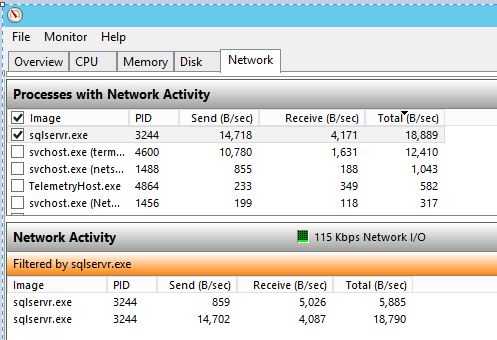标签:
官方文档的定义,是指SQL Server 产生的结果集需要经过Network传递到Client,Network不能很快将结果集传输到Client,导致结果集仍然驻留在SQL Server的Session中,可能的原因是结果集非常大,或者Network带宽小,传输慢。
ASYNC_NETWORK_IO:Occurs on network writes when the task is blocked behind the network. Verify that the client is processing data from the server.
引用《Wait statistics, or please tell me where it hurts》
ASYNC_NETWORK_IO : This is usually where SQL Server is waiting for a client to finish consuming data. It could be that the client has asked for a very large amount of data or just that it’s consuming reeeeeally slowly because of poor programming – I rarely see this being a network issue. Clients often process one row at a time – called RBAR or Row-By-Agonizing-Row – instead of caching the data on the client and acknowledging to SQL Server immediately.
使用Resource Monitor 查看Server的Network Activity

The ASYNC_NETWORK_IO wait indicates that one of two scenarios are happening. The first scenario is that the session (i.e., SPID) is waiting for the client application to process the result set and send a signal back to SQL Server that it is ready to process more data. The second is that there may be a network performance issue.
Reducing SQL Server waits / wait times
If there are significant wait times on ASYNC_NETWORK_IO you have the following options:
If the above tuning tips are reviewed and applied, but the server is still encountering high wait times, then ensure there aren’t any network-related issues:
Also worth mention is the common practice of performing data loads on the server. It is possible that you may be seeing the ASYNC_NETWORK_IO wait during the times that the data loads are occurring.If this is the case then make sure the shared memory protocol is enabled for the SQL Server instance and the session is connected using net_transport = ‘Shared memory’.
You can determine the net_transport for the connection by looking at the DMV – sys.dm_exec_connections.
参考文档:
Wait statistics, or please tell me where it hurts
标签:
原文地址:http://www.cnblogs.com/ljhdo/p/5161417.html